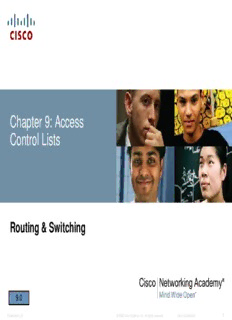
Chapter 9: Access Control Lists - cnacad.com PDF
Preview Chapter 9: Access Control Lists - cnacad.com
Chapter 9: Access Control Lists Routing & Switching 9.0 Presentation_ID © 2008 Cisco Systems, Inc. All rights reserved. Cisco Confidential 1 Chapter 9 9.1 IP ACL Operation 9.2 Standard IPv4 ACLs 9.3 Extended IPv4 ACLSs 9.4 Contextual Unit: Debug with ACLs 9.5 Troubleshoot ACLs 9.6 Contextual Unit: IPv6 ACLs 9.7 Summary 9.0 Presentation_ID © 2008 Cisco Systems, Inc. All rights reserved. Cisco Confidential 2 Chapter 9: Objectives Explain how ACLs are used to filter traffic. Compare standard and extended IPv4 ACLs. Explain how ACLs use wildcard masks. Explain the guidelines for creating ACLs. Explain the guidelines for placement of ACLs. Configure standard IPv4 ACLs to filter traffic according to networking requirements. Modify a standard IPv4 ACL using sequence numbers. Configure a standard ACL to secure vty access. 9.0.1.1 Presentation_ID © 2008 Cisco Systems, Inc. All rights reserved. Cisco Confidential 3 Chapter 9: Objectives (continued) Explain the structure of an extended access control entry (ACE). Configure extended IPv4 ACLs to filter traffic according to networking requirements. Configure an ACL to limit debug output. Explain how a router processes packets when an ACL is applied. Troubleshoot common ACL errors using CLI commands. Compare IPv4 and IPv6 ACL creation. Configure IPv6 ACLs to filter traffic according to networking requirements. 9.0.1.1 Presentation_ID © 2008 Cisco Systems, Inc. All rights reserved. Cisco Confidential 4 Purpose of ACLs What is an ACL? 9.1.1.1 Presentation_ID © 2008 Cisco Systems, Inc. All rights reserved. Cisco Confidential 5 Purpose of ACLs A TCP Conversation Do animations and buttons on 9.1.1.2 9.1.1.2 Presentation_ID © 2008 Cisco Systems, Inc. All rights reserved. Cisco Confidential 6 Purpose of ACLs Packet Filtering Packet filtering, sometimes called static packet filtering, controls access to a network by analyzing the incoming and outgoing packets and passing or dropping them based on given criteria, such as the source IP address, destination IP addresses, and the protocol carried within the packet. A router acts as a packet filter when it forwards or denies packets according to filtering rules. An ACL is a sequential list of permit or deny statements, known as access control entries (ACEs). 9.1.1.3 Presentation_ID © 2008 Cisco Systems, Inc. All rights reserved. Cisco Confidential 7 Purpose of ACLs Packet Filtering (Cont.) 9.1.1.4 Presentation_ID © 2008 Cisco Systems, Inc. All rights reserved. Cisco Confidential 8 Purpose of ACLs ACL Operation The last statement of an ACL is always an implicit deny. This statement is automatically inserted at the end of each ACL even though it is not physically present. The implicit deny blocks all traffic. Because of this implicit deny, an ACL that does not have at least one permit statement will block all traffic. 9.1.1.5 Presentation_ID © 2008 Cisco Systems, Inc. All rights reserved. Cisco Confidential 9 Standard versus Extended IPv4 ACLs Types of Cisco IPv4 ACLs Standard ACLs Extended ACLs Do buttons on 9.1.2.1 9.1.2.1 Presentation_ID © 2008 Cisco Systems, Inc. All rights reserved. Cisco Confidential 10
Description: